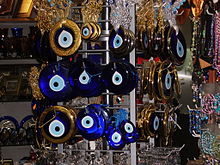Nazar amulet


Nazar amulets are blue, eye-shaped amulets that are common in some oriental countries , which according to popular belief are supposed to avert the evil eye . The name originally comes from the Arabic expression Nazar /نظر / Naẓar , which among other things stands for “seeing, looking, insight”. In Turkish, nazar boncuğu denotes the Nazar amulet or literally the eye pearl, the terms mavi boncuk (blue pearl) or göz boncuğu (eye pearl) are also used. In Greek the amulet is called mati (μάτι, "eye").
In popular belief, people with light blue eyes have the ominous look. A “blue eye” should be used as a counter-magic to banish and avert this gaze.
Nazar pearls are often attached to the clothes of small children against the Evil Eye, hang as amulets omnipresent on the inside rearview mirror of many taxis and trucks or serve as an ornament on the key chain. However, you can also find them at the entrance door to cattle sheds. If an "eye" breaks, it has obviously done its job and averted an evil eye - and is quickly replaced by a new one.
A Nazar amulet is mostly made of colored glass. It is often shaped like a drop of water. Smaller specimens are the size of a pearl and larger ones are the size of a flat disk. The characteristic of the Nazar amulet are its colors: from the inside to the outside concentric circles similar to the iris of an eye in the colors black or dark blue, light blue, white and dark blue. It is therefore often called the “blue eye”. Another name is "Eye of Fatima ", named after the youngest daughter of the Prophet Mohammed . In the Middle East and North Africa, the defense symbol Hand of Fatima is often combined with a Nazar.
Nazar pearls come in all sizes and designs, from pinhead to plate sizes, in bazaars and souvenir shops. It is usually worn in the small form as jewelry on the body or in the larger version hung clearly visible on a wall (preferably opposite an entrance or a door) in order to confront the " evil " clearly. Its counterpart - the "Evil Eye" - on the other hand, cannot be purchased.
Individual evidence
- ↑ See for example CBM Hoffer: The practice of islamic healing . In: WAR Shadid, PS van Koningsveld (ed.): Islam in Dutch Society: Current Developments and Future Prospects , Kok Pharos, Kampen, NL 1992, pp. 40–55, here 42 ( available from Google Books ), with further literature .
- ↑ See Ronald T. Marchese: The fabric of life. Cultural transformation in Turkish society , Binghamton University, New York 2004, 103 ff. ( Available from Google Books).
Web links
- The blue glass eye, blue pearl - Nazar Boncugu - to ward off the evil eye ( Memento from May 6, 2010 in the Internet Archive )
